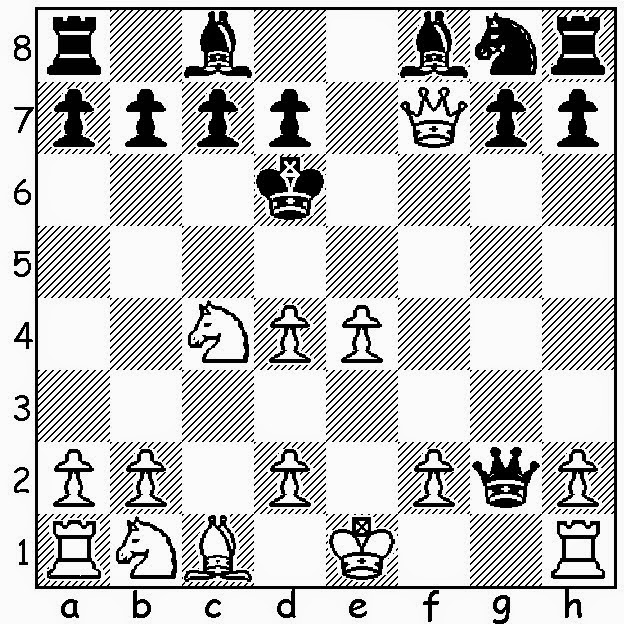We continue from the two previous posts, considering a game that has lept to the top of the heap for Jerome Gambit (1.e4 e5 2.Nf3 Nc6 3.Bc4 Bc5 4.Bxf7+) games this year.
As indicated, Readers are encouraged to dispute my assessment, if they wish, by sending in other great Jerome Gambit games...
Wall, Bill - Guest871838
PlayChess.com, 2014
Black elects with 10...Bd7 to defend his King by putting a barrier - the Bishop - on the 7th rank, and allows the White Queen to move off of the 8th rank. Although I was initially dismissive of this move, describing it as "[p]layed, if in a stumbling manner" - see "Updating the Blackburne Defense (Part 2)" - it is a reasonable choice.
In the meantime, while White is up an exchange and a couple of pawns, he has to safeguard his King while keeping an eye on threats to his Queen.
11.Qxc7
Not 11.Qxa8, of course, as Black responds 11...Ng4 (11... Nxe4?UNPREDICTABLE - choron, FICS, 2009 [1-0, 20]) and White is doomed, as Bill Wall points out: 12.h3 Bxf2+ 13. Kh1 Qg3 14. Rxf2+ Nxf2+ 15. Kg1 Nxh3+ 16. Kh1 Nf4 and 17...Qxg2 mate)
11...Rc8
Instructive was 11...Bb6 (this should let White off of the hook) 12.g3 (better is 12.Qxd6 or 12.Qxb7) Qh3 13.Qxd6 (better is 13.Qc3) Bc6 14.g4 Qxg4+ White resigned, Harris,S - Quayle,E, Los Angeles, CA, 1944. The "right" move at the wrong time often turns out to be the wrong move.
12.g3
Bill points out that 12.Qxb7 was the right move here. Black's best response would then be 12...Bb6, when White can both strike in the center and open a line for much-needed development with 13.d4.
Answering the recommended 12.Qxb7 with 12...Ng4 would be an error, i.e. 13.Qxd7+ Kf6 14.h3. After the alternative 12... Ke7 the game is "gloriously obscure" according to Dr. Andrew Walker (private communication, 2001) although the first player shows his advantage after 13.d4 Bxd4 14.Nd2 Qg4 15.Nf3 (reporting for duty!) Bb6 16.Bg5 Rc7 17.Qb8 Rc8 18.Bxf6+ Kxf6 19.Qxd6+ Qe6 20.Rad1.
12...Qh3
Keeping the pressure on. Houdini suggests that after the alternative 12...Qxe4 13.d3 Qb4 14.Bd2 Rxc7 15.Bxb4 Bxb4 16.c3 the game is about even, with White having a Rook and 2 pawns vs Black's two Bishops.
13.Qxb7
Not 13.Qa5, Bill warns, as then 12...Ng4 mates.
13...Ke7
Bill points out that here Black misses the stunning 13...Rb8! as 14.Qxb8 Ng4 again leads to mate. Even after the better 14.Qc7, White is almost hopeless after 14...Ke7.
White is ahead the exchange and four pawns - but is only even, due to his delay in development, his offside Queen, and his endangered King.
[to be continued]






















